Can we work with a MOSFET only in the linear region? I want to use it as variable resistor so it can provide a fixed amount of current. The MOSFET SOA should not be violated.
-
1You would need a specific MOSFET in mind (link to the datasheet) to determine if its SOA would not be violated. – Null Mar 03 '22 at 12:41
-
Does this answer your question? [Capacitor charging with a MOSFET](https://electronics.stackexchange.com/questions/610604/capacitor-charging-with-a-mosfet) – hacktastical Mar 03 '22 at 22:52
2 Answers
Can we work with the MOSFET only in the linear region?
Only if you keep \$I_{D}\$ significantly below where it starts to operate in the saturation region: -
Image from here.
If your \$V_{GS}-V_{TH}\$ is (say) 4 volts then, to keep in the MOSFET's linear region (characteristics like above), you should aim not to push more than about 10 amps into the drain. If you exceeded this, because the \$V_{GS}-V_{TH}\$ is fairly low, you might encounter thermal runaway and the MOSFET would become destroyed.
If, however, you were operating with \$V_{GS}-V_{TH}\$ above about 6 volts (and this voltage was also above the zero temperature coefficient for the device) you will be able to take drain currents of probably up to 30 amps.
However, the graph above is not representative of any particular MOSFET and so, you should focus on the graphs in the data sheet for the device you might consider suitable.
Here's a hint; if you need a wide range of gate control, don't pick a MOSFET designed specifically for switching applications as these are likely to be the types of device that are more susceptible to thermal runaway. Choose a device that is listed or categorized as suitable for linear applications.
- 434,556
- 28
- 351
- 777
-
In my case, i want to draw max 1A current so I can charge the 1500uf capacitor in 200ms. Can you suggest how can I find a PMOS which meets this criteria? – sikhar Mar 03 '22 at 13:07
-
1I would recommend you work out what the maximum voltage is and look in places like Farnell for prospective devices: https://uk.farnell.com/w/c/semiconductors-discretes/fets/single-mosfets?transistor-polarity=p-channel&continuous-drain-current-id=2.1a_to_381a&drain-source-voltage-vds=100v&range=inc-in-stock - I've filtered this already for 2 amps and 100 volt P channel MOSFETs. – Andy aka Mar 03 '22 at 13:15
-
In my case, supply voltage is 25 to 40V. And any suggestion how to control the gate of PMOS for limited time. Like for 200ms PMOS provide 1A and then shut off. I am making a precharge path for battery. I think PWM signal should be applied at gate..? – sikhar Mar 03 '22 at 14:28
-
1@sikhar I have ideas of course but you should think about what power supplies you have and what load is connected and rise times and fall times and possibly raise a new question so that folk who are not aware of this question can more easily get involved. Remember, this site is a Question and answer site and not a forum. – Andy aka Mar 03 '22 at 15:07
-
oKha...I have some information which will help. My power supply range is 25V to 42V. A capacitive load (1500uf) will be there. It is a DC link capacitor. This capacitor will be charged in 200ms and once this is charged, the precharge FET should be off and I can turn on my main switches. I don't have idea about rise time and fall time. But my main concern is to control the gate voltage in a manner so that it charge the cap. and turn off. Also MOSFET should not violated it's SOA. – sikhar Mar 03 '22 at 15:21
-
Remember that this is a Q and A site and that if you wish to know how to do this it would be better to ask a new question with all the details just provided. I'm not going to attempt any design work within the constraints of this question @sikhar – Andy aka Mar 03 '22 at 16:55
You can use a MOSFET as a voltage controlled resistor.
I built just such a thing a few days ago to illustrate some ways not to control a motor.
The circuit works just like your proposed circuit. Varying the gate voltage varies the current through the MOSFET and the motor.
Since my little demonstration circuit was not intended for real use, I simply used the first MOSFET I found in my junk box. The voltage and current provided by the power supply was also quite low, making the choice of the MOSFET uncritical.
Things to consider:
- Heatsinking. The transistor will get hot when operated in its linear range. You need a heatsink to keep it cool.
- Maximum voltage between drain and source.
- Maximum voltage between gate and source.
- Maximum current through drain and source.
- Maximum dissipated power.
- 67,678
- 8
- 104
- 179
-
Thanks for this great idea. Although, as per theoritical aspects, capacitor takes 5T to charge upto supply voltage level. So in my case if cap value is 1500uf and 200ms to charge it upto supply voltage. It means R should be around 26.6ohm resistor. But i don't want to use R, due to too much power loss. SO use the PMOS in linear region and control the gate voltage. So it can 1A current. Supply voltage can vary from 25V to 40V. – sikhar Mar 03 '22 at 13:41

